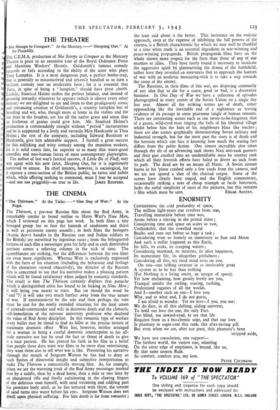THE CINEMA
The Thirteen, a pre-war Russian film about the Red Army, is remarkably similar in broad outline to Harry Watt's Nine Men, which I reviewed on this page last week. In both films a tiny besieged group has to face the hazards of sandstorm and thirst as well as persistent enemy assaults ; in both films the besiegers (Asiatic desert bandits in the Russian case and Italian soldiers in the British) are outwitted by ingenious ruses ; from the beleaguered fortress of each film a messenger goes for help and to each diminished garrison comes a relieving column in the nick of time. The resemblances are striking, but the differences between the two films are even more .significant. Whereas Watt is exclusively engrossed with the facts of his situation (including the behaviour and feelings of his characters viewed objectively), the director of the Russian film is concerned to' see that his narrative makes a pleasing pattern which will be found satisfactory when judged by romantic standards. The result is that The Thirteen certainly displays that panache. which a distinguished critic has found to be lacking in Nine Men ; it will bring you nearer to tears. But (or should the word be " and "?) it will take you much further away from the true nature of war. If entertainment be the sole end then perhaps the vote must be cast for the neatly rounded situation, for the final union of comrade-commander and wife in decorous death and the climactic self-immolation of the nervous university professor who doubted the value of Red Army discipline. In this romantic type of warfare every bullet may be timed to find its billet at the precise instant of maximum dramatic effect Watt has, however, neither arranged for a woman to bring a careful domestic counterpoint to his all- male narrative nor has he used the fact or threat of death to give it a neat pattern. He has pinned his faith in his film to a belief that people these days want war films to be more than entertaining, they want them also to tell what war is like. Presenting his narrative through the mouth of Sergeant Watson he has had to deny us such flashes of directorial insight and subjective interpretation as make The Thirteen a romantically moving film. As, for example, when we see the wavering track of the Red Army messenger marked first by a saddle, then by a dead horse, then a mile or two later by an abandoned rifle and finally culminating in the clawing fingers of the delirious man himself, with sand streaming and eddying past his prostrate body until, as he lies tortured with thirst, the torrent of sand turns into water before his eyes. Sergeant Watson does not (Awe'', upon physical suffering. For him death is far from romantic ;
the least said about it the better. This insistence on the realistic approach, even at the expense of inhibiting the full powers of the cinema, is a British characteristic for which we may well be thankful at a time when truth is an essential ingredient in war-winning and peace-winning propaganda. British propaganda films have on the whole shown more respect for the facts than those of any of our enemies or allies. They have rarely found it necessary to Inculcate the aggressive spirit by glamourising the drama of the battlefield, rather have they revealed sn awareness that to approach the horrors of war with an aesthetic measuring-stick is to take a step towards the camp of the enemy. The Russians, in their films of this war are disposing summarily of any idea that to die for, a cause, good or bad, is a decorative business. In One Day of War we have a collection of episodes photographed in every corner of the Soviet Union on a single day last year. Almost all the striking scenes are of death, either approaching like the inevitable end of a nightmare or leaving evidence of its passage in some gruesome tangle of human remains. There are contrasting scenes such as one never-to-be-forgotten shot of a gaunt, wild-eyed man ringing the bells of his liberated village whilst below him the huts of his neighbours blaze like torches ; there are also scenes graphically demonstrating Soviet military and industrial strength, but for the most part the story is of death and the heroism which can face it knowing how much the searing fact differs from the polite fiction One almost incredible shot taken through the slit of an advancing tank shows Nazi anti-tank gunners and their gun crushed into an unidentifiable mess by another tank which all their feverish efforts have failed to divert an inch from its path. The dead are by no means all Nazis. A Soviet airman burns in his 'plane crashed only a few yards from the camera, and we are not spared a shot of the charred corpse. Some of the scenes have clearly been staged, and the English commentary, occasionally striking a note of cheap triumph or facile bitterness, lacks the awful simplicity of most of the pictures, but this remains


























 Previous page
Previous page